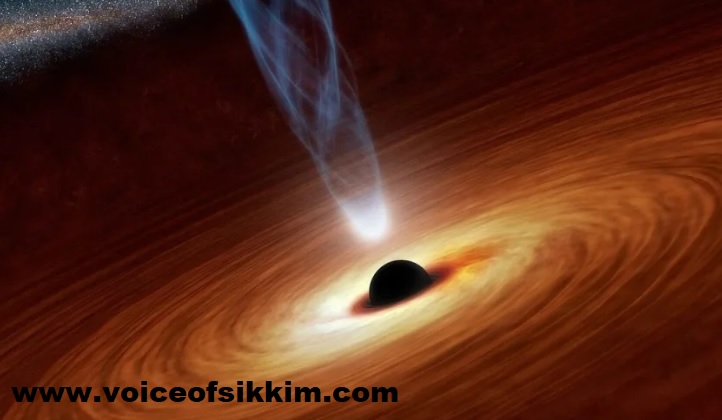
Pakyong, 27 March : Researchers have found a supermassive black hole that is currently oriented toward Earth, and they have determined its implications.
Although the revelation has generated enthusiasm among numerous scientists due to the fresh avenues it could open up for examining black holes, there is also apprehension about the potential ramifications for Earth.
The Royal Astronomical Society’s scientists have made a significant discovery that has caused excitement in the field of astronomy. A supermassive black hole located in the PBC J2333.9-2343 galaxy, situated 657 million light-years away, has altered its direction and is now facing Earth. This black hole is positioned at the center of a blazar, an intense object known as one of the most potent occurrences in the universe. As a result, the galaxy has expanded to almost 40 times the size of the Milky Way, measuring almost 4 million light-years in diameter.
An international group of astronomers has found a galaxy that has undergone a reclassification due to exceptional activity in its core. The galaxy, previously identified as a radio galaxy, has been named PBC J2333.9-2343, and new research has shown that it is not a radio galaxy.
The RAS posted a picture on their Twitter account depicting a supermassive black hole with an outward jet. The accompanying caption explained that it was an artist’s rendering of an active supermassive black hole consuming matter, emitting a jet at almost the speed of light.
After reclassifying the galaxy, previously labeled a radio galaxy, scientists observed that the relativistic jet of its supermassive black hole had shifted up to 90 degrees, now pointing directly towards Earth. The cause of this phenomenon is still unknown, but researchers speculate that it could have been caused by a collision between PBC J2333.9-2343 and another galaxy, resulting in a change of direction.
While many scientists are excited about this discovery and the potential for further black hole research, some are concerned about the impact it could have on Earth. The black hole now directly facing Earth could cause disturbances within our galaxy.
About Black Hole
Space’s black holes are among the most intriguing and mysterious objects. Theories of a conspiracy include the idea that planets always rotate and that black holes consume stars. What is a black hole, then? Simply put, a black hole is a location in space with a tremendous amount of gravitational pull. In 1916, Albert Einstein made his first prediction about the existence of black holes. However, American astronomer John Wheeler invented the term “black hole” in 1967.
What is a black hole?
A black hole, as defined by NASA (National Aeronautics and Space Administration), is a location in space where gravity is so strong that light cannot escape. Because no light can escape, black holes cannot be seen. Black holes cannot therefore be seen by humans. Black holes are discovered by using specialized instruments and space telescopes. Over the years, research has shed some light on black holes, including their size and formation.
What is the size of black holes?
Black holes fall into four categories: small, supermassive, intermediate, and stellar Scientists claim that the smallest black holes are the size of one atom. “Supermassive” is the name given to the largest black holes. Together, these black holes have masses greater than one million suns.
According to scientists, the universe began with the formation of the smallest black holes. However, the origin of supermassive black holes remains a mystery to scientists. A merger of hundreds or thousands of smaller black holes could form supermassive black holes. Each system is accepted to have supermassive dark openings at its focal point.
Can Earth be destroyed by a black hole?
Many people believe that black holes eat planets, stars, and moons as they move through space. This notion has been disproved by scientists. Since no black hole is sufficiently close to our solar system to pose a threat to Earth, NASA claims that Earth would not be swallowed by a black hole with the same mass as the sun. Earth and the other planets, on the other hand, would continue to orbit the black hole in the same manner as they do the sun.
For breaking news and live news updates, like us on Facebook fb.com/thevoiceofsikkim or follow us on Twitter twitter.com/thevoicesikkim and Instagram instagram.com/thevoiceofsikkim. Visit www.voiceofsikkim.com.







